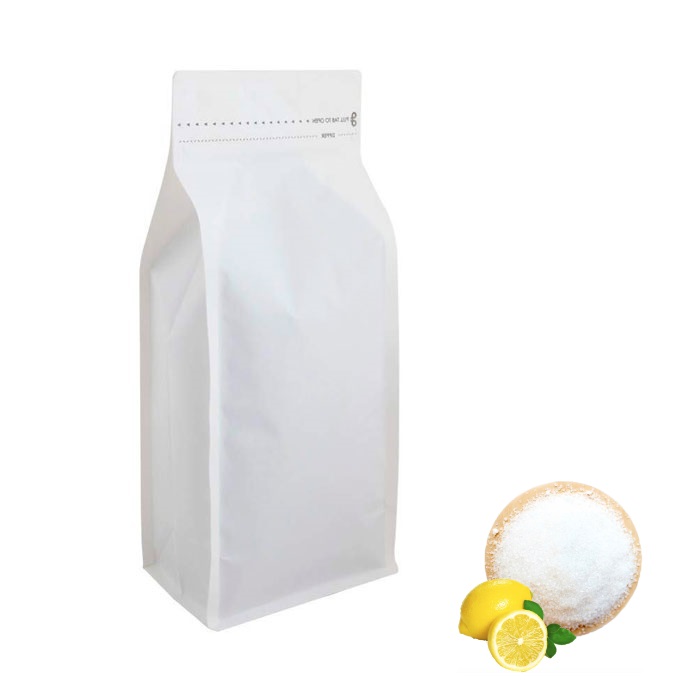Description
Citric acid: food additive E330
Anhydrous citric acid (C6H8O7) is a fine crystalline white powder. Unlike monohydrate, there are no water molecules in its crystal lattice, only citric acid, which is why it is called anhydrous. Food grade anhydrous citric acid is highly soluble in water and ethanol. Citric acid is a natural or synthetic antioxidant. Contained in many fruits: citrus fruits, cranberries, pomegranates, pineapples. The taste is purely sour, not astringent. Participates in metabolism in the body. Citric acid has properties common to all carboxylic acids.
Salts and esters of citric acid are called citrates. When heated above 175 °C, it decomposes into carbon dioxide and water. Citric acid is registered as a food additive with code E-330.
Production
Currently, the main way of industrial production of citric acid is biosynthesis from sugar or sugary substances (molasses) by industrial strains of the mold fungus Aspergillus niger, or by fermentation of sweet waste from sugar production – molasses. In addition, citric acid is isolated from plant materials – lemon, shag leaves, pineapple waste.
Application
Anhydrous citric acid is widely used in the food and pharmaceutical industries, as an antiseptic, seasoning, and also in cosmetology.
- Anhydrous citric acid is used as an acidulant in the production of effervescent vitamin preparations, analgesic powders and water-free tablet dosage forms.
- It is an ideal acidifier in the production of those products where the presence of water, even in crystalline form, can harm the consumer qualities of the finished product, for example, “dry” drinks, food concentrates, some caramels, etc.
- Being a natural food acid, anhydrous citric acid (E 330) is widely used in carbonated and non-carbonated, alcoholic and non-alcoholic drinks, protecting products from the decomposing influence of traces of heavy metals contained in them.
- The excellent taste properties of citric acid make it an ideal component in the preparation of confectionery, caramels, ice cream, jams, jellies, canned fruit and berries.
- Citric acid is an integral part of many cosmetic preparations: elixirs, lotions, creams, shampoos, hair fixatives, etc.
- Citric acid refines tobacco by binding its volatile bases and is used in winemaking and the leather industry. In case of lead poisoning, it converts lead into a difficult-to-digest compound.
- The formation of complexes of citric acid with iron compounds is used to wash it with a solution of the steam-water path of power units at power plants, heat exchangers and other equipment.
Food grade anhydrous citric acid is registered as a food additive E330.
Citric acid monohydrate is widely used
- in the food industry as an acidity regulator, antioxidant and preservative (E330); to protect fats from spoilage, as a food additive in the confectionery industry, in the production of juices, canned food, etc.
- as a component of buffer solutions;
- in the pharmaceutical industry as a component of many medicines (Na citrate is an anticoagulant);
- as a reagent for removing rust and scale from metal surfaces, during electroetching of copper, in tanning solutions in calico printing, in the production of diazo paper;
- for the production of citric acid esters used as plasticizers, etc.
Food grade citric acid monohydrate (monohydrate) is registered as a food additive E330.
Citric acid (2-hydroxy-1,2,3-propanetricarboxylic acid, 3-hydroxy-3-carboxypentanedioic acid) (C6H8O7) is a white crystalline substance, highly soluble in water, soluble in ethyl alcohol, slightly soluble in diethyl ether. Weak tribasic acid. Salts and esters of citric acid are called citrates. The acid itself, as well as its salts (sodium citrate, potassium citrate, calcium citrate, bismuth tripotassium dicitrate), is widely used as a flavoring additive, acidity regulator and preservative in the food industry (food additives E330-E333), for the production of beverages, including fizzy. In the oil and fat industry, citric acid protects products from the decomposing effects of traces of heavy metals contained in them, by forming complex compounds with them. In this way, the likelihood of rancidity of fats, margarines and animal oils is significantly reduced.
Security
Signal word – Warning
Stickers (Pictogram) – GHS07

Hazard statements –
H319 – Causes serious eye irritation.
H335 – May cause respiratory irritation.
May form combustible dust concentrations in air
Precautionary statements –
P280 – Wear safety goggles/face protection.
P305 + P351 + P338 – IF IN EYES: Rinse cautiously with water for several minutes. Remove contact lenses if you have them and this is easy to do. Continue rinsing
P304 + P340 – IF INHALED: Remove victim to fresh air and keep breathing comfortable
P312 – Call a POISON CENTER/doctor if you feel unwell.








